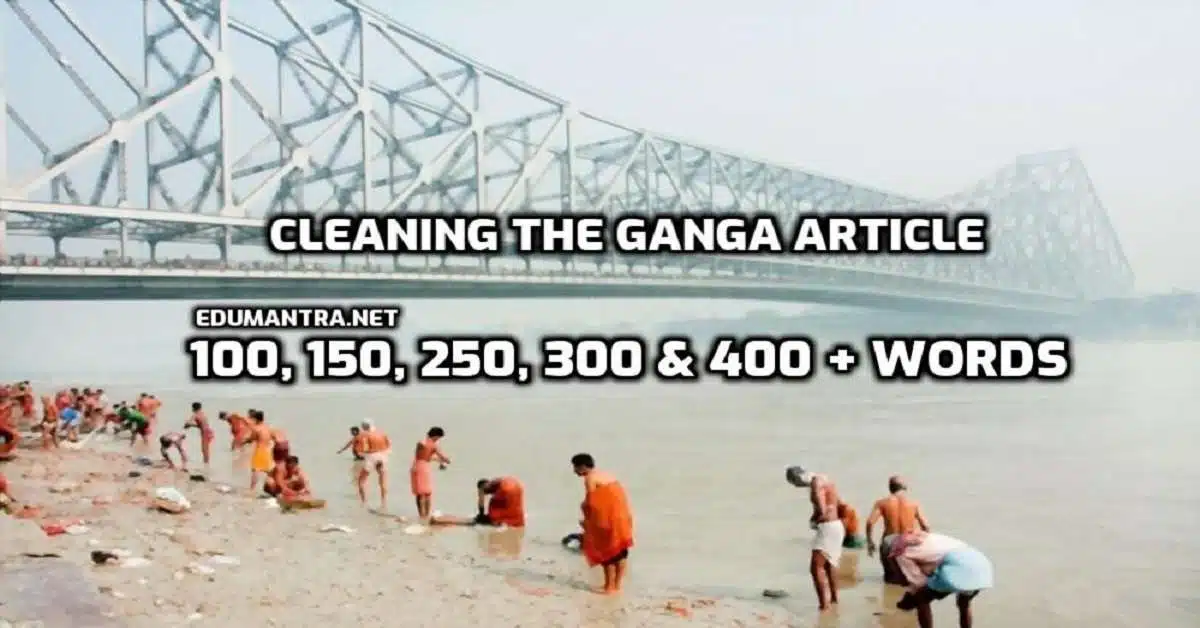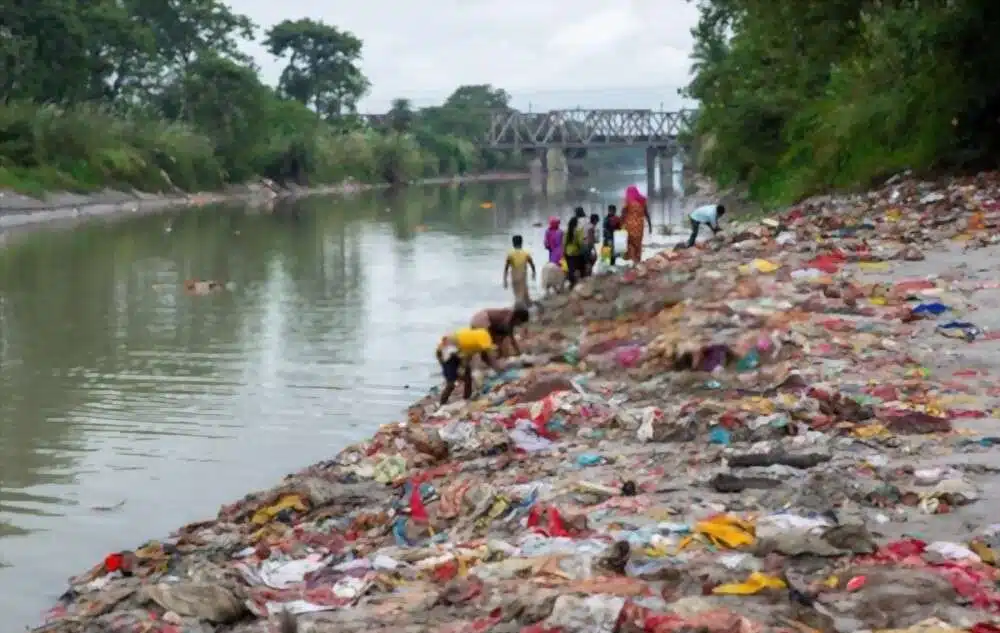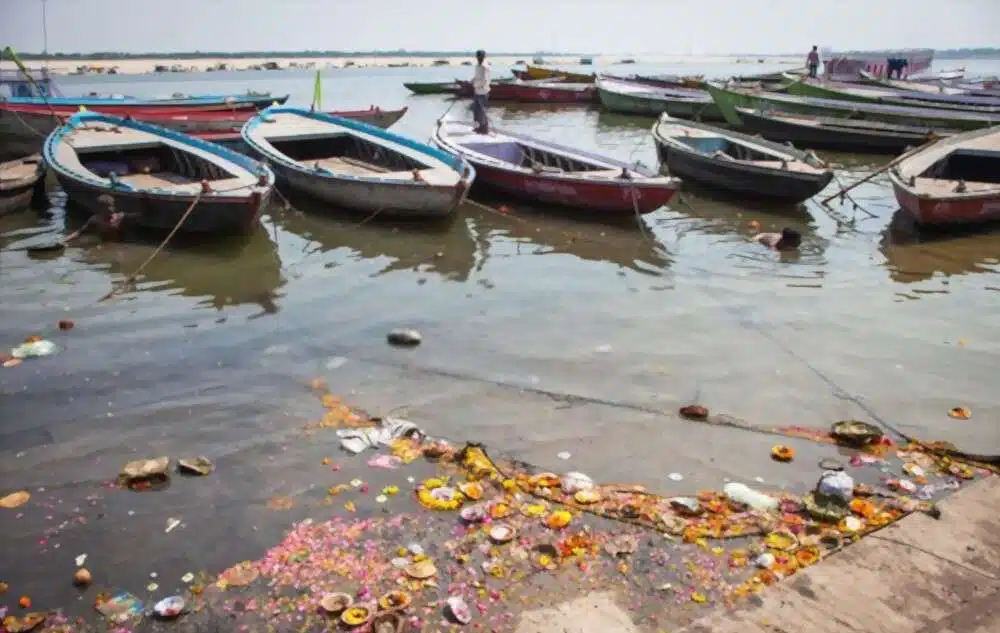
Cleaning the Ganga Article – The Ganga is the longest river in India and one of the most polluted rivers in the world, but cleaning it up will take a lot of time and money.
Taking help from the verbal input given below along with your own views, write an article on ‘Cleaning and Rejuvenating the Ganga’. You are Nikhil/Neha.
Hints: • Cleaning the Ganga • an unprecedented national social effort • Govt. committed to clean and rejuvenate the Ganga • SC not satisfied • a time bond proposal to fulfil the mission • inland waterways • river navigation • extending sewerage infrastructure • prevent open defecation • restoring wholesomeness of the Ganga • development of ghats • Zero liquid discharge by industries • provisions for public amenities for pilgrims and tourists.
Ans. Cleaning and Rejuvenating the Ganga
— Nikhil/Neha
The Ganga is not pretty a river for all the Indians and more particularly to the Hindus, but it is the lifeline of India and the physical and spiritual nourisher of crores of its people. It is a symbol of India’s great heritage, ancient traditions, cultures, songs and stories. We can’t think of India without the Ganga and the Himalayas.
Unfortunately, the sacred Ganga has become one of the most polluted rivers of the world in recent years. Fortunately, the Modi government has shown its commitment to clean and rejuvenate the Ganga. Uma Bharti heads a specially created ministry for cleaning the holy river. Cleaning the Ganga will be an unprecedented national social effort. What makes the Ganga a heavily polluted river? Various factors and causes contribute to making the river what it is.
The worst criminals are more than one thousand industries that discharge their toxic wastes into the river. The government will have to take strict measures to treat solid and liquid discharges making them totally pollution-free. The sewerage infrastructure will have to be extended and updated. The people residing on the banks will be involved and enlightened. Burning and throwing of dead bodies into the river must be stopped. Open defecation on the banks will have to be stopped.
Development of ghats at Kedarnath, Haridwar, Varanasi, Kanpur, Allahabad and Patna is an important feature of the plan. Provisions for public amenities for pilgrims and tourists will be made. Inland waterways river navigation will be another priority.
Download the above article in PDF (Printable)
Article on Cleaning and Rejuvenating the Ganga- 100 Words

The Ganga, one of the most sacred rivers in India, is in dire need of cleaning. Rejuvenation of Ganga is urgently needed. The river is polluted with sewage and industrial effluent. Its pristine waters are now a murky brown. The government has launched several initiatives to clean up the river, but so far these have had little success.
Now, a new initiative called the Namami Gange Programme is being implemented by the government, with the aim of comprehensive conservation and rejuvenation of the river. The programme includes measures for sewage treatment, industrial effluent treatment, solid waste management, riverfront development and afforestation.
Time will tell whether this new initiative will be successful in cleaning up the Ganga. But there is no doubt that it is a herculean task, and one that needs to be tackled urgently if the river is to be saved.
Short Essay on Clean Ganga River- 150 Words

The Ganga is one of India’s most important rivers, and a major religious and cultural icon. The river is considered sacred by Hindus, who believe it cleanses people of their sins. Unfortunately, the Ganga suffers from severe pollution problems.
Over the years, the river has been polluted by industrial effluents, municipal waste, agricultural runoff, and individual sewage. This pollution is caused by humans activities such as manufacturing, farming, and pollution from vehicles. In addition to Pollution from human activities, the Ganga also suffers from water-borne diseases such as diarrhea and dysentery.
The Indian government has launched many initiatives aimed at cleaning up the Ganga. These include building infrastructure like sewage treatment plants and creating awareness among citizens about the importance of clean water. However, much more needs to be done in order to restore the Ganga to its former glory.
Clean Ganga Mission Essay- 250 Words

The Ganga River is a polluted river in India that has been identified as one of the most polluted rivers in the world. The Ganga River is also home to a large number of settlements and industries that contribute to its pollution. In order to clean up this river, the Indian government has initiated a mission called “Ganga Cleanup Mission”. The goal of this mission is to prevent the further spread of pollution and to improve the living conditions of the people who live along the Ganga River.
The Ganga Cleanup Mission has two main objectives: first, it wants to reduce the number of pollutants flowing into the river from urban areas; and second, it wants to improve water quality in the river by removing sediment and contaminants. To achieve these goals, the mission employs a variety of methods, including helipads, dredgers, and jetties. The government has also set up treatment plants along major tributaries of the Ganga River so that polluting waste can be diverted away from it.
So far, the Cleanup Mission has been successful in reducing pollution levels in many parts of India. However, there is still a lot of work left to be done before the river can be called clean. In addition to reducing pollution levels, more needs to be done to improve access to health care and education for residents living near the river. Additionally, there is need for better enforcement of environmental laws so that polluters are brought under control. Hopefully, with continued
Article on Cleaning River Ganga- 300 Words
The Ganga is one of the holiest rivers in Hinduism. Cleaning the Ganga is an important task that needs to be done in order to keep it clean and free from pollutants. It is also one of the most polluted rivers in the world.. The river is said to have over 600 million gallons of sewage and industrial effluent released each day into its waters, making it one of the most challenging environmental projects in history.
The river, which is considered a religious place by many people, needs to be kept free of all kinds of contaminants in order to maintain its sanctity.
The cleaning of the Ganga has been a priority for the government for years now but the impacts are hardly seen. There are several ways in which cleaning can be done, and various organizations have been set up specifically to carry out this task.
There are many methods for cleaning the Ganga, but most require significant investment and commitment from both government and private sector partners. Some proposals include constructing large dams to block upstream flows, drilling wells to extract groundwater, or building treatment plants that can remove pollutants from water before it reaches the river. Despite these challenges, there are some encouraging signs that progress is being made. In recent years, India has announced plans to build dozens of new waste-to-energy plants across the country, and several major cities have started work on underground drainage systems that would quickly remove rainwater and other contaminants from gutters before it enters streams and rivers.
While much remains to be done, cleaning up the Ganga represents an important step in restoring India’s degraded environment and ensuring its continued prosperity. Cleaning the Ganga is an arduous task, but one that is necessary if we want to keep this important religious site clean and free from pollutants.
Long Article on Cleaning and Rejuvenating the Ganga 1000 Words
Cleaning the Ganga Article
It’s no secret that the Ganga is one of the most polluted rivers in the world. Pollution from industrial and agricultural runoff, sewage treatment plants, and other sources has caused it to become a hotbed for environmental disaster. The situation is so dire that the World Health Organization has declared the Ganga a “public health emergency”, and it’s just one river among many that are in desperate need of attention.
In this article, we will explore some ways you can help clean up the Ganga. From donating money to groups working to improve sewage infrastructure to volunteering your time to cleaning up sites near your home, there are many ways you can contribute to restoring this sacred river.
The Ganga is the World’s Largest and Oldest River-
The Ganga is the world’s largest and oldest river. It originates in the Himalayas and flows through India and Bangladesh before emptying into the Bay of Bengal. The Ganga has a long history of being a source of water, transportation, trade, and religion. It is also one of the most polluted rivers in the world.
The Ganga is often polluted because of human activity, such as dumping of waste into the river. Polluting substances can include chemicals from factories, sewage from cities, and agricultural runoff. In addition, heavy metals from industrial waste and pesticides can pollute the river.
To address the pollution problem, the government of India has implemented a number of policies to clean up the Ganga. These policies include building new wastewater treatment plants and improving existing ones, installing sewerage lines in rural areas, and cleaning up riversides with sand filters and wetlands. In addition, the Indian government plans to develop other sources of renewable energy to replace fossil fuels used to power industrial processes that pollute the Ganga.
The Ganga is One of the World’s Most Polluted Rivers
The Ganga is one of the world’s most polluted rivers. Around 270 million people in India depend on its water for their livelihoods, yet the river is plagued with pollution from a variety of sources. The majority of the pollution comes from agricultural waste and sewage discharge, but industrial and municipal emissions also contribute.
The Ganga is also susceptible to flash flooding as heavy rains wash pollutants into the river. In 2016, heavy rains caused widespread flooding in northern India, killing more than 200 people and contaminating much of the Ganges with raw sewage and industrial effluents.
Attempts to clean up the Ganga have been made for many years but have been hampered by political instability and a lack of funding. In 2015, Prime Minister Narendra Modi announced an ambitious plan to clean up the Ganga by 2022, but it remains to be seen if this will be successful.
Projects for Cleaning River Ganga
Ganga cleaning has been going on for years and there are many organizations working to keep the Ganges clean. The most important part of this effort is awareness. By educating people about the importance of keeping the Ganga clean, they will be more likely to participate in efforts to keep it clean. There are also a number of projects being undertaken to clean up the Ganga. Some examples include:
- A project called Nirmal Bharat aims to build sewage treatment plants along the banks of the river in order to reduce pollution levels.
- Another project called Namami Gange aims to create awareness about environmental issues and encourage people to take action in order to improve sanitation conditions and protect water resources.
- A project called Swachh Bharat Mission involves building toilets and shower facilities all over India in order to reduce open defecation and increase hygiene levels.
Sources of Pollution for River Ganga
There are many sources of pollution in the Ganges, including sewage and industrial waste. Industrial sites along the river have caused acid rain and toxic effluents that have harmed wildlife and plants. Agricultural runoff from fields also contributes to water pollution. Sewage discharge from households and factories adds to the problem.
The river has been designated a UNESCO World Heritage Site due to its cultural significance, but cleaning it up will require concerted efforts from governments, businesses, and individuals alike. Some measures that have been taken to improve quality of life along the Ganges include constructing wastewater treatment facilities and encouraging people to use public transportation instead of cars.
The Government of India Needs to be More Strict to Clean the Ganga
The Ganga, one of the most important rivers in India, is in need of a serious clean up. Pollution from industrial and domestic sources has caused the river to become heavily contaminated with pollutants such as mercury and lead. The government of India needs to take serious action to clean up the Ganga.
The Ganga Estuary Program was started in 1993 with the goal of cleaning up the estuary and restoring its natural environment. However, progress has been slow due to protests from industry and lack of funding. In 2010, the Indian government announced plans to invest $8 billion over a period of five years in order to improve water quality and remove pollutants from the river. However, these plans have yet to be implemented due to resistance from industry.
If the government fails to take action soon, there could be serious consequences for both humans and wildlife. Mercury levels in the Ganga are high enough that they can cause health problems even at very low doses if ingested through food or water. Additionally, pollution levels have led to an increase in fish diseases and reduced populations of aquatic animals such as turtles and dolphins. If this trend continues, it will be difficult for people living near the Ganga River to continue accessing essential water resources.
The Indian government needs to take immediate steps to clean up the Ganges River if it wants protect its citizens and environment from significant harm.
The Different Types of Pollutants that Enter the River Ganga
The river Ganga is affected by a variety of pollutants, which include industrial and agricultural waste, untreated domestic sewage and effluents from factories said to have healing properties. However, the river is also polluted with a variety of pollutants that can harm both humans and wildlife.
Some of the main pollutants that enter the Ganga are lead, mercury, pesticides, and industrial waste. All of these substances can have serious environmental consequences if they are discharged into water bodies.
Lead is a particularly dangerous pollutant because it can cause developmental problems in children who are exposed to high levels of lead. Mercury can also have harmful effects on humans if ingested or inhaled. Pesticides can damage plant life and contaminate water supplies with harmful chemicals. Finally, industrial waste contains toxic substances that can pollute waterways if released untreated.
All of these pollutants need to be taken seriously if they are going to be cleaned up from the Ganga River. There are a number of ways that this goal could be achieved, including legislation and public education campaigns. In addition, projects like the installation of pollution control devices at power plants may help reduce the amount of hazardous material entering the river.
Challenges in Cleaning the Ganga
Despite critical efforts to clean it up over the last few years, the river is still home to many pollutants, including heavy metals and industrial chemicals.
The Ganga is also a victim of illegal fishing, which contributes to its pollution. And because the river flows through densely populated areas, it’s also difficult to clean up after accidents or other spills.
Nonetheless, there are many organizations working to improve the Ganga’s health and cleanliness. These groups rely on volunteers and donations to carry out their work., the Ganga continues to face significant challenges in terms of pollution and sanitation.
There are a number of reasons for this:
First, as with many other rivers in India, the Ganga is heavily reliant on manual labor for its cleanup.
Second, upstream factories and farms release large amounts of pollutants into the river, which flow downstream untreated.
And finally, there is a lack of infrastructure and resources devoted to monitoring and cleaning up the river.
What Can be Done to Clean the River Ganga-
Despite these challenges, there are a number of things that can be done to help improve conditions for the Ganga River:
First, more needs to be done to promote sustainable farming practices upstream. This will help reduce the amount of pollutants released into the river and help improve water quality downstream.
Second, better sanitation facilities need to be built along the banks of the Ganga so that people have access to proper hygiene supplies and refuse disposal systems. This would prevent human waste from contaminating water sources downstream and facilitate cleaner water use overall.
Third, government agencies need to invest in better monitoring systems so that they can identify and address issues quickly and effectively.
The Effects of Pollution on the Ganga
Pollution from industry, agriculture, and sewage disposal has caused the river to experience high levels of toxins and bacteria. This has had a negative effect on the river’s ecosystem, causing the following:
There has been a decline in fish populations and an increase in waterborne diseases.
The Ganga also suffers from heavy levels of sedimentation, which makes it difficult for boats to navigate effects on both the environment and human health.
Pollution from industry causes acid rain, which destroys trees and crops. Agricultural pollution from manure and fertilizers runoff into rivers causes water shortages and creates toxic algae blooms that can kill fish. Sewage discharge also pollutes rivers with harmful chemicals that can cause respiratory problems in people living near rivers.
How can We Support to Clean the Ganga
There are a few ways that we can support cleaning the Ganga. We can help fund organizations who work to clean the river, lobby for better government policies, or donate to charities that work on environmental projects.
The Role of the People in Keeping the Ganga Clean
There are a number of things that people can do to help keep the Ganga clean.
First, they can stop dumping their own sewage and garbage into the river.
Second, they can support initiatives to clean up industrial waste.
Finally, they can raise awareness about the importance of keeping the Ganga clean and encourage others to do their part.
The government has launched a number of campaigns to clean up the Ganga, but these have not been successful without the support of the people. Only by working together can we hope to keep this sacred river clean.
Conclusion
Laws have been enacted to address some of the environmental pollution caused by humans, but much more needs to be done to clean up the Ganga. A comprehensive plan is needed to address all sources of pollution as well as develop innovative ways to treat wastewater before it reaches a river. Until then, the Ganga will continue to suffer from harmful effects both inside and outside of India’s borders.
People Also Ask:
1.How can we rejuvenate Ganga?
Ans: We can rejuvenate Ganga by cleaning up the pollution, planting trees along the river, and creating more awareness about the importance of keeping the river clean.
2.How is Ganga being cleaned?
Ans: There are a few ways in which the Ganga is being cleaned. The first is by the construction of dams and barrages. This helps to control the flow of the river and to sedimentation. The second way is by afforestation. This helps to stabilize the banks of the river and to prevents erosion. The third way is by setting up sewage treatment plants. This helps to treat the sewage before it enters the river.
3.What are the initiatives taken to clean the Ganga in clean Ganga campaign?
Ans: The main initiative taken in the clean Ganga campaign is to create awareness among the people living in the vicinity of the river about the importance of keeping the river clean. This is done through various awareness programs and campaigns. Another initiative is to set up sewage treatment plants along the river so that the effluents generated from domestic and industrial sources are treated before being discharged into the river.
Want to Read More:-
152. The Need for Communal Harmony
153. ‘Population Explosion’ in India
154. The Prize Distribution Function
156. The Evil of Drug Addiction
158. Value of Discipline in Life
160. War on Black Money in India
